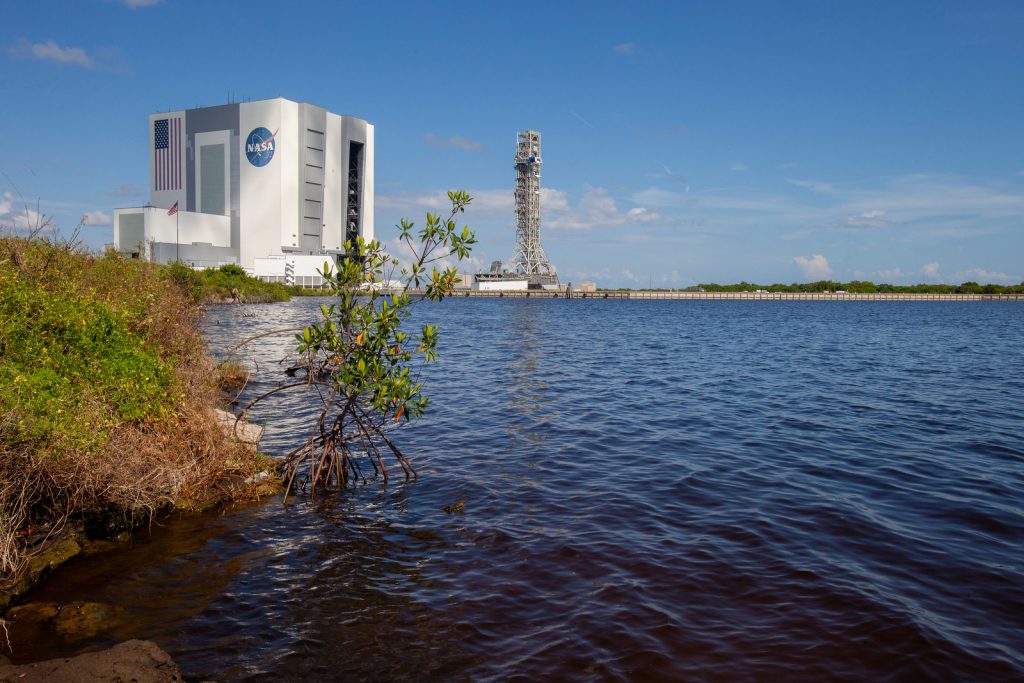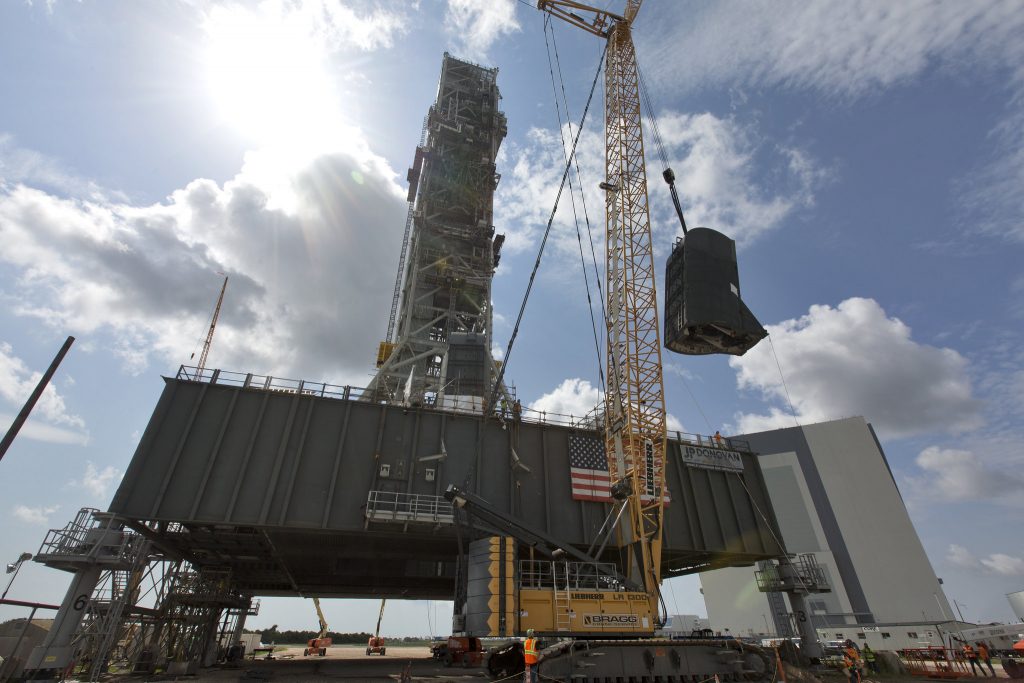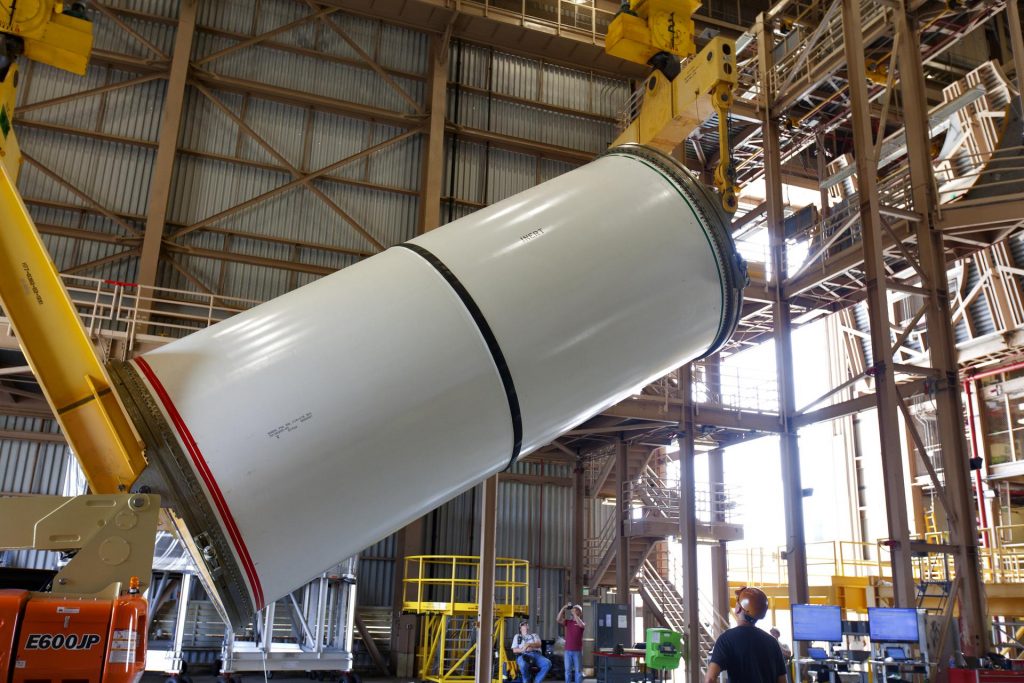This blog site is no longer updated. For the latest news from NASA’s Exploration Ground Systems, visit the website at http://www.nasa.gov/egs.
Category: Exploration Ground Systems
Mobile Launcher Rolls Back to Launch Pad 39B
 The mobile launcher for NASA’s Artemis missions rolls out of the Vehicle Assembly Building (VAB) at Kennedy Space Center in Florida on Sept. 10, 2019, after spending a week and a half inside due to the approach of Hurricane Dorian. The nearly 400-foot-tall structure was moved from Launch Pad 39B to the VAB for safekeeping on Aug. 30. The storm passed about 70 miles east of the spaceport during the overnight hours Tuesday, Sept. 3, and Wednesday, Sept. 4.
The mobile launcher for NASA’s Artemis missions rolls out of the Vehicle Assembly Building (VAB) at Kennedy Space Center in Florida on Sept. 10, 2019, after spending a week and a half inside due to the approach of Hurricane Dorian. The nearly 400-foot-tall structure was moved from Launch Pad 39B to the VAB for safekeeping on Aug. 30. The storm passed about 70 miles east of the spaceport during the overnight hours Tuesday, Sept. 3, and Wednesday, Sept. 4.
NASA’s Exploration Ground Systems is moving the mobile launcher back to the launch pad, where teams will complete testing and checkout on the launcher in the coming weeks for the Artemis I mission.
Photo credit: NASA/Ben Smegelsky
Bragging Rights for Mobile Launcher Lifters and Iron Workers

Operating a heavy-lift crane and working with some of the strongest metals on Earth takes precise diligence, skill and patience. Bragg Crane & Rigging Co. of Long Beach, California, has worked in the industry since 1946, and its team members embody these skills each day as they lift and weld a launch structure that will take America back to the Moon and on to Mars.
For the past four years, Bragg Crane & Rigging Co. has been supporting Kennedy Space Center’s Exploration Ground Systems (EGS) program, playing a crucial role in preparing the program’s mobile launcher for NASA’s Artemis missions. The company has had unique opportunities to lift and install most of the critical umbilicals to the mobile launcher that will provide power to the Space Launch System (SLS) and Orion spacecraft while on the launch pad. Among the major umbilical components the company installed were the crew access arm, which will allow astronauts to climb aboard the Orion spacecraft, and the tail service mast umbilicals, which provide fuel and electrical connection to the rocket.
During peak operations, the company had approximately 120 employees assembling the launcher, bringing NASA one step closer to putting the first woman and next man on the Moon. Bragg Crane & Rigging Co. is looking forward to supporting NASA’s missions to the Moon and beyond in the coming months under a new contract to continue to prepare the Vehicle Assembly Building for the integration of the massive SLS rocket.
Rotation, Processing and Surge Facility Ready for Artemis 1

The Rotation, Processing and Surge Facility (RPSF) at NASA’s Kennedy Space Center in Florida will receive the solid rocket booster segments for final assembly of NASA’s Space Launch System (SLS) rocket. The agency’s Exploration Ground Systems (EGS) team successfully completed the system acceptance review and operational readiness review for the facility on July 25, 2019. This review evaluated the RPSF’s readiness to receive, process, integrate and launch flight hardware for Artemis 1 and beyond.
“The RPSF is the first processing facility at Kennedy to reach operational readiness status, and our team is looking forward to the arrival of the flight hardware so we can get to work preparing for the Artemis 1 launch,” said Mike Chappell, EGS associate program manager with lead contractor, Jacobs.
When the booster segments arrive at Kennedy, the pieces are inspected before two 200-ton cranes are positioned to lift the segments from a horizontal position to a vertical position. The RPSF also will receive the booster aft skirt from the Booster Fabrication Facility. During processing, the aft segment is attached to the aft skirt and aft exit cone.
All of the SLS solid rocket components processed in the RPSF will be transported to the Vehicle Assembly Building for final assembly with the SLS core stage and Orion spacecraft on top of the mobile launcher for the agency’s Artemis missions.
The RPSF is part of the infrastructure at Kennedy that will help NASA launch the Artemis missions and send the first woman and next man back to the Moon by 2024.
